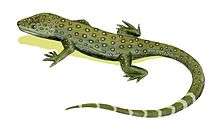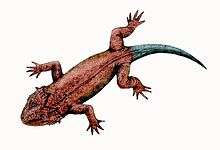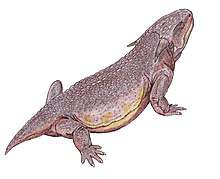Embrithosaurus
Embrithosaurus was a pareiasaur from the Permian of South Africa.[1]
| Embrithosaurus | |
|---|---|
| Scientific classification | |
| Kingdom: | |
| Phylum: | |
| Class: | |
| Order: | |
| Family: | |
| Genus: | †Embrithosaurus Watson, 1914 |
| Type species | |
| †Embrithosaurus schwarzi Watson, 1914 | |
| Species | |
| |
| Synonyms | |
| |
Description
Embrithosaurus was 3 metres (9 ft 10 in) in length and 600 kilograms (1,300 lb) in weight.The skull is relatively deep and narrow. The body is lightly armoured with thin, smooth dermal scutes.
Species
E. alexanderi (Haughton and Boonstra, 1929); this species was made the type for " Dolichopareia". As the name indicates, the skull is long and narrow. This would seem to indicate a different lifestyle or diet to other parieasaurs. More recently, it has been used as the monotypal species for the genus Nochelesaurus (it is not clear what the status of Embrithosaurus strubeni is, this may be a further transitional species). In cladistic analyses, this species is phylogenetically intermediate between Bradysaurus seeleyi and Embrithosaurus schwarzi .
E. schwarzi (Watson, 1914);the type species. This is the most advanced species of this genus, as indicated by the teeth, which have nine cusps (in three groups of three). In cladistic analyses it is used as the monotypal species for the genus.
E. strubeni (Broom, 1924);the skull is large and deep, pointed at the front, and elevated in the jugal region. This species was originally made the type species of Nochelosaurus by Haughton and Boonstra. Boonstra later (1969) moved it into the genus Bradysaurus, on the basis of the primitive tooth structure. Kuhn however considers it belongs under Embrithosaurus.






